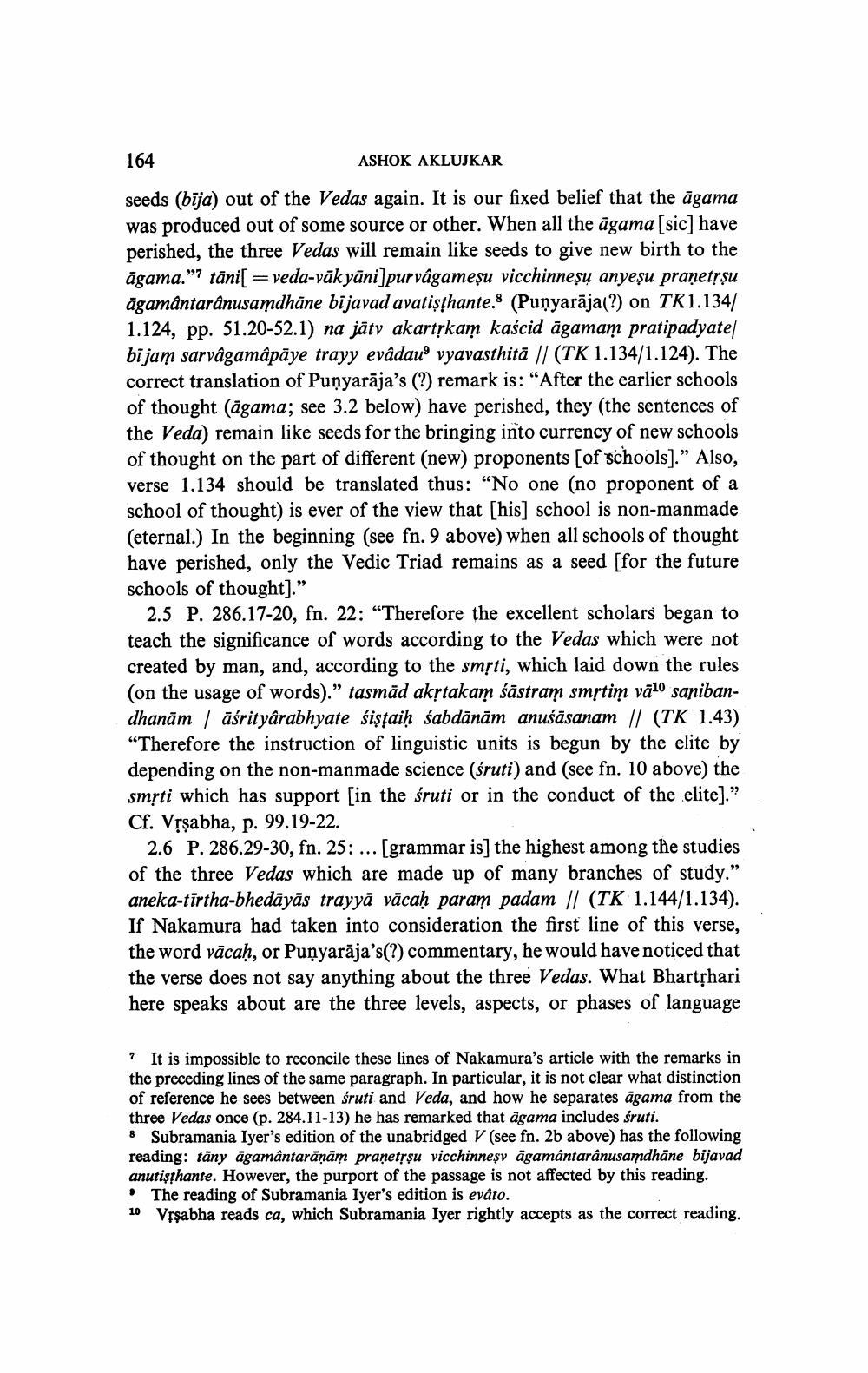Book Title: Nakamura On Bhartrhari Author(s): Ashok Aklujkar Publisher: Ashok Aklujkar View full book textPage 4
________________ 164 ASHOK AKLUJKAR seeds (bija) out of the Vedas again. It is our fixed belief that the agama was produced out of some source or other. When all the āgama [sic] have perished, the three Vedas will remain like seeds to give new birth to the āgama.”? tāni[=veda-vākyāni]purvâgameșu vicchinneşų anyesu pranetrşu āgamântarânusamdhāne bijavad avatişthante. (Punyarāja(?) on TK 1.134/ 1.124, pp. 51.20-52.1) na jäty akartȚkam kaścid āgamam pratipadyate bijam sarvâgamâpāye trayy evâdauo vyavasthitā // (TK 1.134/1.124). The correct translation of Punyarāja's (?) remark is: “After the earlier schools of thought (agama; see 3.2 below) have perished, they (the sentences of the Veda) remain like seeds for the bringing into currency of new schools of thought on the part of different (new) proponents (of schools]." Also, verse 1.134 should be translated thus: “No one (no proponent of a school of thought) is ever of the view that (his) school is non-manmade (eternal.) In the beginning (see fn. 9 above) when all schools of thought have perished, only the Vedic Triad remains as a seed (for the future schools of thought]." 2.5 P. 286.17-20, fn. 22: “Therefore the excellent scholars began to teach the significance of words according to the Vedas which were not created by man, and, according to the smrti, which laid down the rules (on the usage of words)." tasmād akstakam śāstram smrtim vālo sanibandhanām / āśrityârabhyate śişțaiḥ śabdānām anuśāsanam || (TK 1.43) “Therefore the instruction of linguistic units is begun by the elite by depending on the non-manmade science (śruti) and (see fn. 10 above) the smộti which has support [in the śruti or in the conduct of the elite].” Cf. Vịşabha, p. 99.19-22. 2.6 P. 286.29-30, fn. 25: ... [grammar is] the highest among the studies of the three Vedas which are made up of many branches of study." aneka-tīrtha-bhedāyās trayyā vācah param padam || (TK 1.144/1.134). If Nakamura had taken into consideration the first line of this verse, the word vācaḥ, or Punyarāja's(?) commentary, he would have noticed that the verse does not say anything about the three Vedas. What Bhartshari here speaks about are the three levels, aspects, or phases of language ? It is impossible to reconcile these lines of Nakamura's article with the remarks in the preceding lines of the same paragraph. In particular, it is not clear what distinction of reference he sees between śruti and Veda, and how he separates agama from the three Vedas once (p. 284.11-13) he has remarked that agama includes śruti. 8 Subramania Iyer's edition of the unabridged V (see fn. 2b above) has the following reading: tāny agamântarāņām pranetȚşu vicchinneșy agamântarânusamdhāne bijavad anutişthante. However, the purport of the passage is not affected by this reading. • The reading of Subramania Iyer's edition is evâto. 10 Vrsabha reads ca, which Subramania Iyer rightly accepts as the correct reading.Page Navigation
1 2 3 4 5 6 7 8 9 10 11 12 13 14 15
